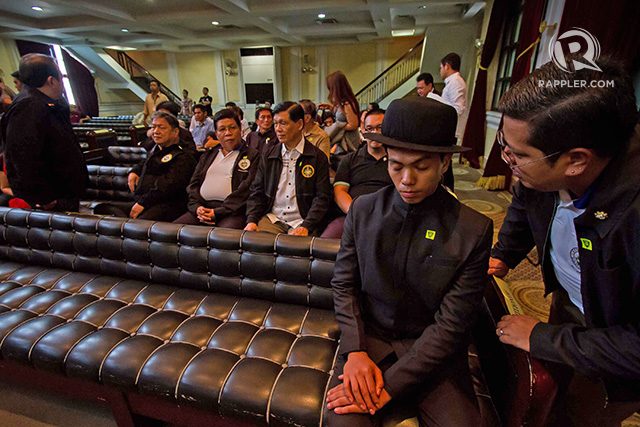SUMMARY
This is AI generated summarization, which may have errors. For context, always refer to the full article.

SC Associate Justice Marvic Leonen grilled Knights of Rizal lawyer William Jasarino during the two-hour oral arguments on the group’s petition to have Torre de Manila torn down because it marred the “visual dominance” of the icon of the national hero.
At the opening of the hearing on Tuesday, July 21, Jasarino presented artists’ renditions of what the background behind the monument would look like if buildings similar to the 49-storey Torre de Manila are allowed to be built.
Among these was a rendition provided by Torre de Manila developer DMCI, which showed several skyscrapers behind the monument. Another showed the same high-rise buildings, this time with large, distracting billboards.
As the “soul of the country,” the icon of Rizal should dominate the landscape, Jasarino argued.
He added that by allowing Torre de Manila to rise behind the monument, it would take away from the “awe” of Rizal.
Leonen, however, was not satisfied with Jasarino’s explanation.
“Is the monument the only sign of Rizal? It is not the monument which is the be-all of the narrative of Rizal,” he said.
He added: “For you to tell us that the Rizal monument is the soul of the nation and we should put that in jurisprudence, we cannot do that….It is tyrannical of the Court to establish the narrative of the nation.”
The SC justice also pointed out that the group’s claim of what the monument stands for does not have enough weight.
“Your statement [is] that the monument is the soul of the country, that putting something at the back of the monument would destroy all historical accounts. That privileges one account of what that monument should be,” Leonen said.
He asked, “You are asking this court to give privilege to that particular account simply [because] it’s not nice to have that Torre at the back, [that] it destroys the soul of the nation. Is that what you are asking this court?” Jasarino replied in the affirmative.
Defending Torre de Manila
Leonen also pointed out that DMCI has the right to construct its projects on private property.
DMCI has argued the same in its defense of the controversial building.
In previous statements, the real estate developer said it obtained the proper documents and clearances to begin work on the condominium, including an exemption from the local zoning laws that would have limited the building to only 7 floors.
Responding to criticism that the high-rise building “photobombs” the Rizal Monument, the company pointed out that the building is situated 800 meters behind the monument.
DMCI also reiterated that it did not violate heritage laws, and was even issued clearance by the National Historical Commission of the Philippines in November 2012.
In June, the Supreme Court stopped the construction of the controversial building.
Respondents’ round
The High Court is set to hold a second round of oral arguments at 2 pm on August 4.
Respondents DMCI, the City of Manila, National Commission for Culture and the Arts, National Museum, and the National Historical Commission of the Philippines are set to present their arguments.
Among other issues, the Court is set to determine whether the constitutional mandate to conserve and protect cultural heritage and resources – such as the historic Rizal Monument – also extends to the preservation of its “prominence, dominance, vista points, vista corridors, sight lines, and setting.”
The SC will also determine the effect of its ruling on shrines and monuments that currently have towers in their line of sight, as well as the damage to be sustained by DMCI, its workers, investors, and buyers of the project, in case the building is demolished. – Rappler.com
Add a comment
How does this make you feel?
There are no comments yet. Add your comment to start the conversation.